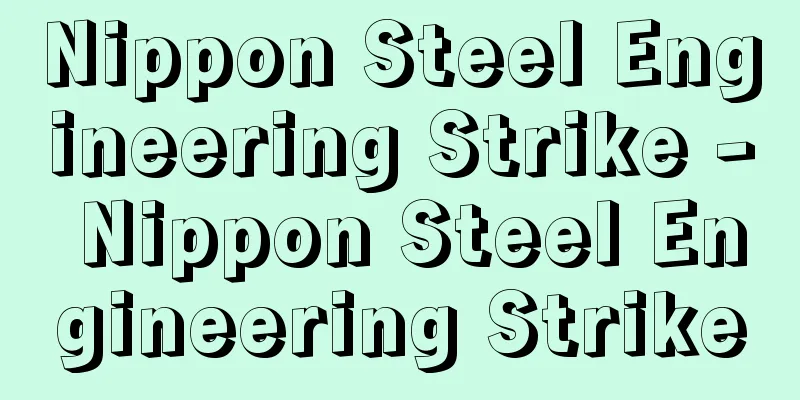Secondary education - Chutokyoiku

|
A stage in school education that is between primary education (elementary school education) and higher education (centered on university education). In the current Japanese education system, it refers to education in junior high school and high school. The concept of secondary education was born in Europe in the mid-19th century, and the schools at the center of secondary education were classical language grammar schools (such as grammar schools in England, lycées and colleges in France, and gymnasiums in Germany) that provided university preparatory education for the elite. Therefore, secondary education was seen as a privileged elite education linked directly to higher education, in contrast to primary education, which was given to the common people as preparation for daily life. Even at the same age, those in a social class who would eventually receive a university education did not enter primary school, but instead went through the primary education department attached to a secondary school or home education before entering secondary school, while those who had graduated from primary school had no path to secondary school, and instead went to higher primary school, vocational school, or the real world. After World War I, the unified school movement arose as part of the democratization movement, and a common primary education (called basic school in Germany and first stage education in France) was established for all national children, and secondary education came to have the character of the second stage education that followed. [Toshiaki Kuwahara] Problems in Secondary EducationSecondary education is always accompanied by a difficult problem. That is, the problem of how to balance the completion education for those who will leave school and enter the real world at this stage with the preparatory education for those who will proceed to higher education. More fundamentally, the problem is how to harmonize a high level of common national education with the individualization of learning and development. Until the Secondary Education Act 1945, the common system was to divide secondary education into three sections, academic, vocational, and practical, and to assign these to different schools. After the war, the integration of secondary education was once again brought up under the slogan "Complete secondary education for all," and countries that had adopted the three-section system are now reforming to comprehensive secondary schools. This reform includes a tendency to divide secondary education into early and late stages, with the early stage being a period in which common education is given while observing aptitude, and the upper stage being a period in which education is gradually given according to the career path of each student according to their characteristics. However, if upper secondary education is considered a time for career-specific education and schools and courses are diversified and subdivided, the negative effects of entrance exam-based education will emerge, as in the case of Japan. It is necessary to recognize that commonalization and communalization, and individualization and personalization in education are not issues that only apply to secondary education, but issues that apply throughout lifelong education as a whole. [Toshiaki Kuwahara] The current state of secondary education in JapanIn Japan today, 96.4% (2008) of junior high school graduates go on to high school, making high school a quasi-compulsory education. In 1999, a partial revision of the School Education Act in 1998 created public "secondary education schools" that provide a unified junior and senior high school education by combining the lower and upper secondary education of junior and senior high schools. In order to provide a stable and relaxed school life during the secondary education period, schools that provide unified junior and senior high school education do not implement an examination system for entering the upper secondary course (high school level). However, on the other hand, it has been pointed out that the number of options (including a selection system) for entering lower secondary education (junior high school level) will increase, which may lead to problems such as a younger age for entrance exam competition and the creation of elite schools. In addition, concerns about the erosion of the single-track 6-3 system achieved by the education reform after World War II and expectations of increasing disparities between high schools have also been added, and the system has not progressed all at once. [Toshiaki Kuwahara] Edited by Uchida Tadasu and Mori Takao, "History of Middle and High Schools" ("School History Vol. 3", 1979, Daiichi Hoki Publishing) ▽ Edited by Mochida Yukio, "International Comparison: The Structure and Function of Modern Secondary Education" (1990, Nagoya University Press) ▽ "Research on Secondary Education Reform - The Case of the Reform of the Upper Level of German Gymnasiums" by Imai Shigetaka (1993, Kazama Shobo) ▽ "History of Japanese Secondary Education as Seen in Documents" by Yoneda Toshihiko (1994, Tokyo Horei Publishing) ▽ "Research on Contemporary Secondary Education Reform in Britain" by Mochida Kengo (1996, Kyushu University Press) ▽ "Edited by Nakajima Akio and Asada Tadashi, "Secondary Education Renaissance - Creating Schools Where Students and Teachers Grow" (2003, Gakuji Publishing) [Reference items] | | | | |Source: Shogakukan Encyclopedia Nipponica About Encyclopedia Nipponica Information | Legend |
|
学校教育の段階区分のうち、初等教育(小学校教育)と高等教育(大学教育を中心とする)の間に位置する段階。日本の現行教育制度に即していえば、中学校と高等学校における教育をいう。 中等教育という概念は、19世紀中葉にヨーロッパに誕生したが、その中心に位置する学校は、大学準備教育をエリートに対して行う古典語文法学校(イギリスのグラマー・スクール、フランスのリセやコレージュ、ドイツのギムナジウムなど)であった。そのため、中等教育とは、庶民を対象に日常生活の準備として行われる初等教育に対置され、高等教育と直結する身分階級的な特権的エリート教育とみなされた。同じ年齢段階でも、やがて大学教育を受けるような社会階層にある者は、小学校に入学するのではなく、中等教育学校に付設されている初等教育部門か家庭教育かを経て中等学校に入学し、一方、小学校卒業者は中等学校に進学する道はなく、高等小学校か職業学校か実社会かに進んだのである。第一次世界大戦後、民主化運動の一環として統一学校運動がおこり、すべての国民子弟に共通の初等教育(ドイツでは基礎学校、フランスでは第一段階教育とよばれる)が確立されて、中等教育はそれに続く第二段階教育の性格をもつこととなった。 [桑原敏明] 中等教育の問題点中等教育には宿命的な難問がつねに付きまとう。すなわち、この段階で学校教育を終えて実社会に出る者に対する完成教育と、さらに高等教育に進学する者に対する準備教育との調整という問題である。より基本的には、高度の国民的共通教養と学習・発達の個性化をどう調和させるかという問題である。第二次世界大戦までは、中等教育を学問的、職業的、実務的の3部門に分化(=3分岐制)し、これを別々の学校に分担させる方式が一般的であった。戦後は「すべての者に完全な中等教育を」を合いことばに、中等教育の統合が改めて問題にされ、3分岐制をとっていた国々でも総合制中等学校への改革を進めている。この改革は、中等教育を前期、後期に区分し、前期中等教育を、共通教育を施しながら適性を観察する時期、後期中等教育を、生徒ひとりひとりの特性に応じて徐々に進路に応じた教育を施す時期とする傾向を含んでいる。しかし、後期中等教育は進路別教育の時期だとして、学校やコースを多様化・細分化してしまうと、日本の例のように、受験教育の弊害が現れる。教育における共通化・共同化と、個性化・個別化は、中等教育だけの問題ではなく、生涯にわたる教育全体を通じた問題だとする認識が必要である。 [桑原敏明] 日本の中等教育の現状今日の日本では、中学校卒業者の96.4%(2008)が高等学校に進学しており、高等学校は準義務教育化しているといえる。 1998年(平成10)の学校教育法一部改正により、1999年に中学校・高等学校の前・後期中等教育をあわせた中高一貫教育を施す公立の「中等教育学校」が誕生した。中高一貫教育を行う学校は、中等教育期間の「ゆとり」ある安定的な学校生活を目的として、後期課程(高校段階)進学時の試験制度を実施しない。しかし、一方では前期中等教育(中学校段階)進学時の選択肢(しかも、選抜制を含む)が増えることとなるため、受験競争の低年齢化や受験エリート校化につながるおそれが生じるなどの問題が指摘されている。また、第二次世界大戦後の学制改革によって達成した単線型六三制侵食への危惧(きぐ)、高等学校間格差の増大への思惑などが加わり、一気には進展していない。 [桑原敏明] 『内田糺・森隆夫編『中学校・高等学校の歴史』(『学校の歴史 第3巻』・1979・第一法規出版)』▽『望田幸男編『国際比較 近代中等教育の構造と機能』(1990・名古屋大学出版会)』▽『今井重孝著『中等教育改革研究――ドイツギムナジウム上級段階改革の事例』(1993・風間書房)』▽『米田俊彦著『資料にみる日本の中等教育の歴史』(1994・東京法令出版)』▽『望田研吾著『現代イギリスの中等教育改革の研究』(1996・九州大学出版会)』▽『中島章夫・浅田匡編著『中等教育ルネッサンス――生徒が育つ・教師が育つ学校づくり』(2003・学事出版)』 [参照項目] | | | | | | | | | | | |出典 小学館 日本大百科全書(ニッポニカ)日本大百科全書(ニッポニカ)について 情報 | 凡例 |
Recommend
Nagoya Railroad - Nagoya Railroad
A private railway company. Founded in 1894 as Aich...
Hanazono [town] - Hanazono
A former town in Osato County in northern Saitama ...
《Pharmacopoeia》 - kyokuho
…A collection of Chinese medical formularies. Its...
Takamine Kenichi - Koho Kenichi
A Rinzai sect monk in the Kamakura period. He was...
Strawberry (strawberry) - Strawberry (English spelling) Fragaria chiloensis var. ananassa; strawberry
In a broad sense, strawberry refers to perennial p...
Quail - Quail
…Because he continued to love, meet and sing abou...
Shellfish poisoning
This phenomenon occurs when bivalve shellfish, mai...
Uncleaned coal
…The products that are separated and removed duri...
Shomp
…All of the languages belong to the Austroasiat...
Acidosis - Acidosis
This refers to a state in which the relationship ...
Optical printer
...However, this method became practical in the 1...
Kim Jae-beom
...Politician of the Democratic People's Repu...
Ignatios (of Constantinople) (English spelling)
…reigned 858-67, 877-86. He was a scholar who tau...
Selection of favorites - Kisenshiki
A book on waka poetry from the mid-Heian period. I...
Kishizawa Shikisa (6th)
[Born] Tempo 4 (1833) [Died] February 1898. A sham...









